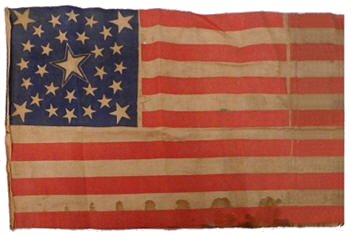|

The earliest American
Flags made by printing the pattern of the flag onto
fabric date to the period of 26 Stars, circa 1837-1845.
Following the election of President James K. Polk in the
Election of 1844, four states were added to the Union:
Florida, the 27th state, on March 3, 1845 (the day
before President Polk took office); Texas, the 28th
state, on December 29, 1845; Iowa, the 28th state,
on December 28, 1846; and Wisconsin, the 30th state, on
May 29, 1848. This beautiful printed flag of 30 Stars
represents Wisconsin. The flag, with its four
large corner stars, striking haloed medallion center
star, outer wreath of 16 stars and inner wreath of 9
stars, is among a handful of the very earliest printed
parade flags. The design and construction of this
flag is very similar to other flags that are known in
the higher star counts including those of the Civil War
era, but this is the earliest star count in this
medallion style. Flags that predate the Civil War
are very rare. Less than one in a hundred American
flags, dating to the 19th century, predate the Civil
War. Flags with counts less than 34 are generally
very scarce and are highly sought after, especially by
those collectors who try to obtain at least one flag of
every star count.


These two homemade Campaign Textiles made for the
1844 Election of President James K. Polk. The 30
Star Flag was introduced during the Polk Administration
when Wisconsin became the 30th State. Surviving campaign materials from the
1844 election in support of the James K. Polk and George
M. Dallas are exceptionally rare. The companion
banner for Silas Wright and Addison Gardiner, was made
by the same hand at the same time. Silas Wright
was offered the Democratic vice presidential nomination
in 1844 but turned it down to pursue the New York
governorship. Wright served as the 14th Governor
of New York from 1845-1846. His Lieutenant
Governor was Addison Gardiner. These banners were
found on the North Shore of Long Island in the area of
Roslyn and Sea Cliff. They are made of hand sewn
and pieced cotton. The pencil markings of the sketched
letters are still visible beneath the writing including
a larger draft letter P. Each has a single
whip-stitched grommet in the lower left corner. |

